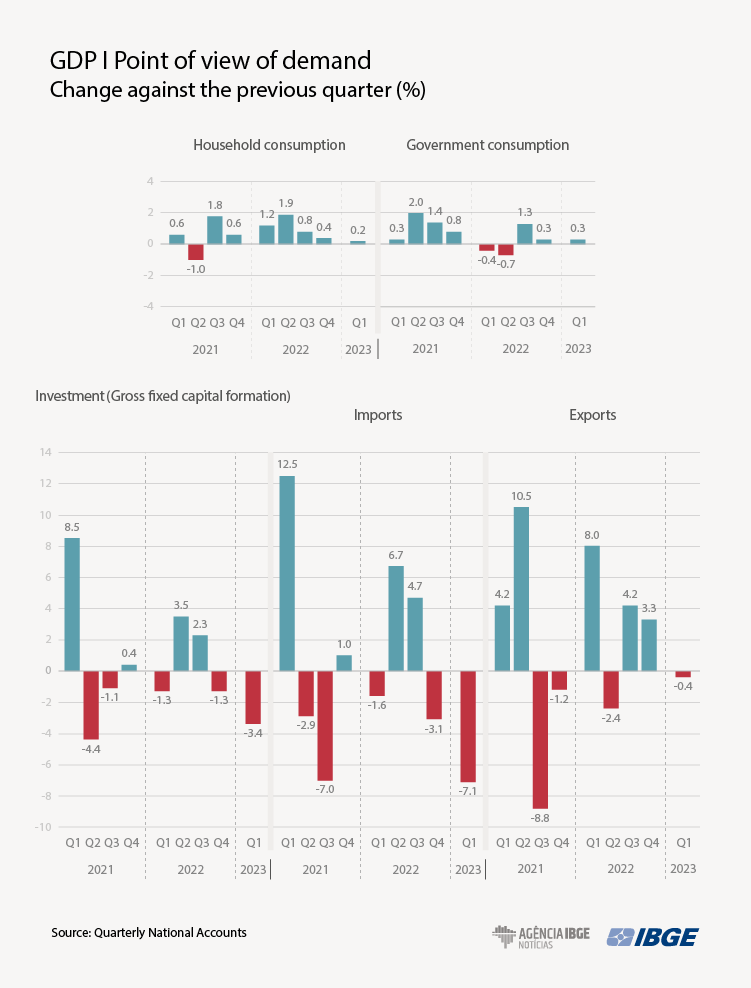National Accounts
GDP grows 1.9% in Q1, leveraged by Agriculture
June 01, 2023 09h00 AM | Last Updated: June 02, 2023 10h34 AM

The Gross Domestic Product (GDP) grew 1.9% in the first quarter this year, compared with the last quarter last year. The result was mainly leveraged by the growth of 21.6% in Agriculture, the highest rise for this sector since the fourth quarter of 1996. The GDP, which is the total final goods and services produced in Brazil, hit R$2.6 trillion at current values.
Compared with the first quarter of 2022, the GDP grew 4.0%. In the cumulative index in the four quarters ended in March 2023, the GDP rose 3.3% in relation to the four immediately previous quarters. The data are from the System of Quarterly National Accounts, released today (1) by the IBGE.

The growth of the GDP was leveraged by the rise in Agriculture (21.6%), which weights nearly 8% in the Brazilian economy.
“Weather problems negatively impacted on Agriculture last year and a record harvest of soybeans is expected for this year, representing nearly 70% of the crops in the quarter and growing more than 24% in terms of output. The soybean harvest is concentrated in the first semester of the year. When comparing the fourth quarter of a bad year with a good first quarter, we notice a significant growth in Agriculture,” analyzes Rebeca Palis, the IBGE Coordinator of National Accounts.
Still on the positive side, the services sector, which has the highest weight in the indicator, grew 0.6% in the period. The result was mainly leveraged by the rise in the sectors of Transportation and Financial Activities, both of them growing 1.2%.
“The rise in the Transportation sector was influenced by both cargo and passenger Transportation and, in the Financial Activities, it was leveraged by insurance, as insurance premiums grew and claims dropped, causing a gain in the sector,” highlights Palis.
On the other hand, the sector of Information and communication (-1.4%) registered the biggest drop in the first quarter for services. “The drop in this activity can be explained, to a great extent, by a high comparison basis. It was the activity that mostly grew after the pandemic and it is 22.3% above the level of the fourth quarter of 2019.”, explains the coordinator.
Industry remained stable (-0.1%) in the first quarter of 2023. “The drop in Manufacturing Industry was influenced by the drops of capital goods and intermediate goods, whereas the activity of Electricity and water, gas, sewage and waste management activities rose 6.4%, since we have good hydric conditions, without any shortage”, states Palis.

Consumption of households changes 0.2%, whereas Gross Fixed Capital Formation falls 3.4%
Under the point of view of expenditure, Household Consumption Expenditure (0.2%) and Government Consumption Expenditure (0.3%) registered positive changes, whereas Gross Fixed Capital Formation (-3.4%) dropped.
The foreign sector positively contributed to the growth, since Exports of Goods and Services recorded a negative change of 0.4% and Imports of Goods and Services fell 7.1% in relation to the fourth quarter of 2022.

Inter-annual GDP grows 4.0%, with Agriculture rising 18.8%
When compared with the same period in the previous year, the GDP grew 4.0% in the first quarter of 2023. Value Added at basic prices rose 4.1% and Taxes on Products Net of Subsidies advanced 3.0%.
Agriculture grew 18.8% in relation to the same period last year. This result can be mainly explained by the good performance of farming products that have a relevant harvest in the first quarter and by productivity. According to the Systematic Survey of Agricultural Production (LSPA/IBGE), soybeans, the major crop, registered a productivity gain and a significant growth in the annual production, estimated at 24.7%. Except for rice (-7.5%), other crops with a relevant harvest this quarter also grew in the annual production and gained productivity, like corn (8.8%), tobacco (3.0%) and cassava (2.1%).
Value added of Services grew 2.9% in the comparison with the same period last year. All their activities rose: Information and communication (6.8%), Transportation, storage and mailing (5.1%), Financial activities, insurance and related services (4.6%), Other services activities (4.3%), Real estate activities (2.8%), Trade (1.6%) and Administration, defense, public health and education, and social security (0.4%).
Industry rose 1.9%. In this context, Mining and quarrying industries (7.7%) recorded the best result, affected by the rise of both petroleum and gas extraction and of iron ore. The activity of Electricity and gas, water, sewage and waste management activities (6.4%) also stood out with the improvement of hydric conditions. Construction (1.5%), in turn, registered the tenth consecutive rise, though decelerating, since the real wage bill of the sector grew, but typical inputs for construction are dropping in relation to the previous year.
About the System of National Accounts
The System of National Accounts presents the current values and the volume indexes for the Gross Domestic Product (GDP) on a quarterly basis at market prices, taxes on products, value added at basic prices, personal consumption, government consumption, Gross Fixed Capital Formation, stock change, exports and imports of goods and services. The survey began in 1988 in the IBGE and it was re-designed from 1998 onwards, when its results were integrated into the System of National Accounts, with an annual periodicity.
Check the data of the System of National Accounts on Sidra. The next release of the GDP, related to the second quarter of 2023, will be on September 1st.


















